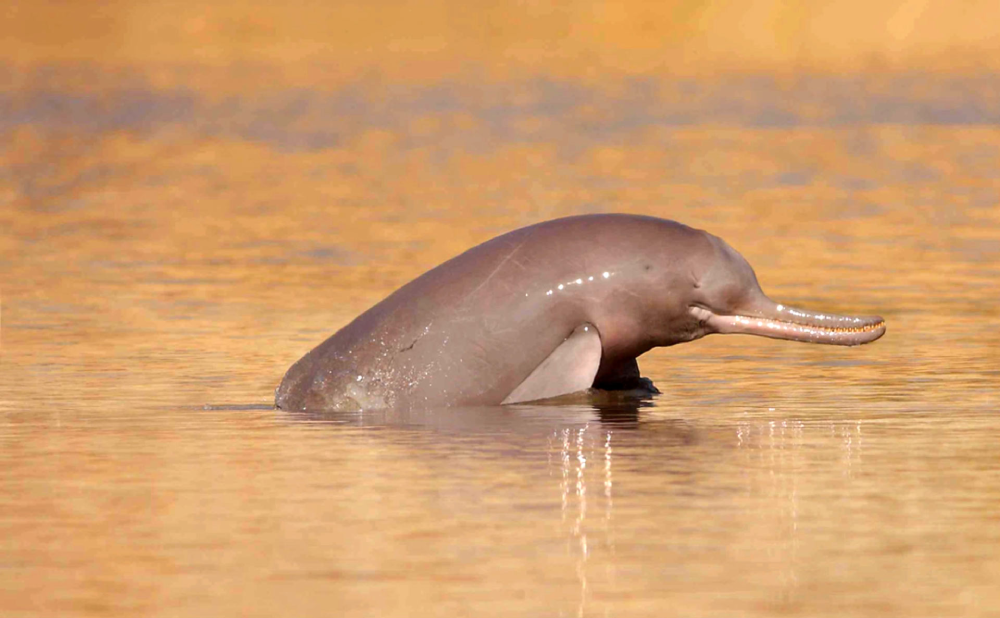The Ganges River Dolphin, scientifically known as *Platanista gangetica*, is a fascinating and unique cetacean that inhabits the murky waters of the Ganges, Brahmaputra, and Meghna river systems in India, Nepal, and Bangladesh. This freshwater dolphin, often referred to as the “Susu” in local dialects, is an integral part of the biodiversity of the Indian subcontinent and holds significant ecological, cultural, and scientific value. Despite its importance, the Ganges River Dolphin faces numerous threats that have led to its classification as an endangered species.
Physical Characteristics and Behavior
The Ganges River Dolphin is popular for its long, slender snout, which is foraging in muddy riverbeds. Adults can grow up to 2.6 meters (8.5 feet) in length and weigh around 85 kilograms (187 pounds). They have a distinctive pinkish-brown color, which can appear more pronounced in older individuals. Their eyes are small, and they rely heavily on echolocation to navigate and hunt in the turbid river waters.
These dolphins are typically solitary or found in small groups. Their diet primarily consists of fish and invertebrates, which they detect using a series of clicks and pulses. Unlike their marine counterparts, Ganges River Dolphins exhibit a unique form of locomotion known as side-swimming, where they use one of their flippers to stabilize themselves while swimming on their sides. This adaptation is thought to aid in navigating the shallow and often complex riverine environments they inhabit.
Ecological Importance
The presence of the Ganges River Dolphin is a key indicator of the health of the river ecosystems they inhabit. As apex predators, they play a crucial role in maintaining the balance of the aquatic food web. Their feeding habits help control the populations of fish and other aquatic organisms, contributing to the overall health and biodiversity of the river systems.
Furthermore, the Ganges River Dolphin serves as a flagship species for conservation efforts. Protecting these dolphins and their habitat leads to broader conservation benefits for other species and the entire river ecosystem, including the human populations that depend on these rivers for their livelihoods.
Cultural and Historical Significance
The Ganges River Dolphin holds a special place in the cultural and religious fabric of the Indian subcontinent. The Ganges River itself is considered sacred in Hinduism, and the presence of these dolphins in its waters adds to the river’s mystique and spiritual significance. Historically, these dolphins were often depicted in ancient Indian art and literature, symbolizing purity and the life-giving properties of the river.
Threats to Survival
Despite their cultural and ecological importance, Ganges River Dolphins face numerous threats that have contributed to their decline. These threats include:
1. Habitat Degradation: Human activities such as dam construction, water extraction for irrigation, and also pollution have significantly altered the natural flow and quality of the rivers. Dams and barrages fragment dolphin habitats, restrict their movement, and reduce the availability of prey.
2. Pollution: Industrial waste, agricultural runoff, and also untreated sewage have severely polluted many parts of the Ganges and Brahmaputra river systems. High levels of toxic substances can lead to health problems for the dolphins and reduce the populations of fish they rely on for food.
3. Fishing Practices: Accidental entanglement in fishing nets (bycatch) is a significant threat. Dolphins can become trapped in gillnets and other types of fishing gear, leading to injury or death.
4. Boat Traffic: Increased boat traffic for transportation and tourism disrupts the dolphins’ natural behavior and habitat. Collisions with boats can cause serious injuries or fatalities.
5. Climate Change: Changes in precipitation patterns and melting glaciers due to climate change can alter the river flow regimes, affecting the habitats and food availability for the dolphins.
Conservation Efforts
Conservation efforts to protect the Ganges River Dolphin have been initiated at various levels, involving government agencies, non-governmental organizations, and local communities. Key strategies include:
1. Legal Protection: The Ganges River Dolphin is under Schedule I of the Indian Wildlife Protection Act, 1972, which provides it with the highest level of protection. It is also included in the Convention on International Trade in Endangered Species (CITES) Appendix I, prohibiting international trade of the species.
2. Habitat Conservation: Efforts are being made to restore and protect critical habitats. This includes the establishment of protected areas, such as the Vikramshila Gangetic Dolphin Sanctuary in Bihar, India.
3. Pollution Control: Initiatives like the Namami Gange Programme aim to reduce pollution in the Ganges River through improved waste management and sewage treatment facilities.
4. Community Involvement: Engaging local communities in conservation efforts is crucial. Awareness programs and involving communities in monitoring and protection activities have shown positive results.
5. Research and Monitoring: Continuous research and monitoring are essential to understand the population dynamics, health status, and threats faced by the dolphins. This information is vital for formulating effective conservation strategies.
The Future of the
The survival of the Ganges River Dolphin hinges on sustained and concerted conservation efforts. While significant challenges remain, there is hope that with increased awareness, stronger legal frameworks, and collaborative conservation initiatives, the population of these unique freshwater dolphins can stabilize and recover.
In conclusion, the Ganges River Dolphin is not just an extraordinary species but a crucial component of the river ecosystems in South Asia. Its plight highlights the broader environmental issues affecting the Ganges and Brahmaputra rivers. So, protecting the Ganges River Dolphin is not only about saving a species. It is also about preserving the health of the rivers that sustain millions of people and a diversity of life.










